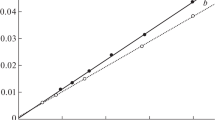Summary
A new equation is derived relating the retention index to the molecular polarizabilities, ionization potentials and permanent dipole moments of the stationary phase and the solute.
Various implications of this equation to quantitative structure-retention relationships are discussed.
Similar content being viewed by others
References
L. Rohrschneider, J. Chromatogr.22, 6 (1966).
L. S. Ettre, Chromatographia7, 261 (1974).
G. Tarján, A. Kiss, G. Kocsis, S. Mészáros, J. M. Tákacs, J. Chromatogr.119, 327 (1976).
P. J. Schoenmakers, H. A. H. Billiet, L. de Galan, Chromatographia15, 205 (1982).
F. Patte, M. Etcheto, P. Laffort, Anal. Chem.54, 2239 (1982).
H. Lamparczyk, A. Radecki, J. High. Resolut. Chromatogr./Chromatogr. Commun.6, 390 (1983).
H. Lamparczyk, D. Wilczyńska, A. Radecki, Chromatographia14, 707 (1981).
H. Lamparczyk, D. Wilczyńska, A. Radecki, Chromatographia17, 302 (1983).
M. Gassiot-Matas, G. Firpo-Pamies, J. Chromatogr.187, 1 (1980).
R. Kaliszan, H. D. Höltje, J. Chromatogr.234, 303 (1982).
M. Randič, J. Amer. Chem. Soc.97, 6609 (1975).
F. Saura-Calixto, A. Garcia-Raso, Chromatographia15, 771 (1982).
J. Bermejo, M. D. Guillen, Chromatographia17, 664 (1983).
R. Kaliszan, H. Lamparczyk, J. Chromatogr. Sci.16, 246 (1978).
J. Grzybowski, H. Lamparczyk, A. Nasal, A. Radecki, J. Chromatogr.196, 217 (1980).
E. K. Whalen-Pedersen, P. C. Jurs, Anal. Chem.53, 2184 (1981).
K. Jinno, A. Ishigaki, J. High. Resolut. Chromatogr./Chromatogr. Commun.5, 668 (1982).
T. R. McGregor, J. Chromatogr. Sci.17, 314 (1979).
E. Kováts, in Advances in Chromatography,J. C. Giddings andR. A. Keller, eds., Vol. 1, M. Dekker Inc., New York 1965; pp. 229–247.
K. J. Miller, J. A. Savchik, J. Amer. Chem. Soc.101, 7206 (1979).
A. Radecki, H. Lamparczyk, R. Kaliszan, Chromatographia12, 595 (1979).
K. D. Bartle, M. L. Lee, S. A. Wise, Chromatographia14, 69 (1981).
S. A. Wise, W. J. Bonnett, F. R. Guenther, W. E. May, J. Chromatogr. Sci.19, 457 (1981).
H. J. Issaq, G. M. Janini, B. Poehland, R. Shipe, G. M. Muschik, Chromatographia14, 655 (1981).
Author information
Authors and Affiliations
Rights and permissions
About this article
Cite this article
Lamparczyk, H., Radecki, A. The role of electric interactions in the retention index concept; Implications in quantitative structure-retention studies. Chromatographia 18, 615–618 (1984). https://doi.org/10.1007/BF02261974
Received:
Accepted:
Issue Date:
DOI: https://doi.org/10.1007/BF02261974




